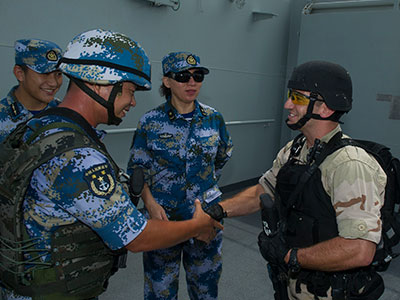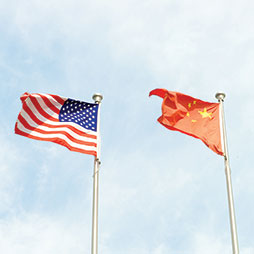Building a New Type of U.S.-China Military-to-Military Relationship
Major General Yao Yunzhu, director of the Center on China-America Defense Relations at the PLA’s Academy of Military Science, discusses the recent positive developments in U.S.-China military-to-military relations.
As part of NBR’s U.S.-China Relations in Strategic Domains project, experts are developing a new paradigm for U.S.-China engagement in the cyber, space, maritime, and nuclear spheres, as well as in two key areas of bilateral exchange: military-to-military and people-to-people relations. The relationship between the U.S. military and the People’s Liberation Army (PLA) forms the core of the U.S.-China strategic relationship and has been an important component of the project’s workshops, discussions, and papers.
Somewhat paradoxically, relations between the U.S. military and the PLA have improved markedly in recent years amid growing tensions between the United States and China. Two salient manifestations of this improvement include an increased number of reciprocal visits by senior military and defense officials as well as a burgeoning array of joint military exercises focusing on humanitarian assistance/disaster relief (HA/DR). Such progress is all the more remarkable given the past impulse of both Washington and Beijing to suspend military-to-military contacts during periods of high tension.
In this Q&A, Major General Yao Yunzhu, director of the Center on China-America Defense Relations at the PLA’s Academy of Military Science, discusses the recent positive developments in U.S.-China military-to-military relations. She argues that relations between the two militaries are in their best shape in over two decades but notes that significant obstacles remain to a more substantive relationship. Dr. Yao also discusses ways in which the two military establishments could cement ties.
At the December 2014 Global Times conference in Beijing, you argued that U.S.-China military-to-military relations were in their best shape since the 1990s. What led you to make this assessment, and do you see this positive trend continuing into 2015?
The U.S.-China military-to-military relationship has been stable since September 2011, with all the planned exchange programs (more than 60 items in 2014 alone) successfully completed. It is important to recall that interactions between the two militaries were suspended seven different times beginning in the early 1990s. This on-and-off mode of engagement was the result of crises in the bilateral relationship such as the 1999 accidental bombing of the Chinese embassy in Belgrade by a U.S. fighter bomber under NATO command, the 2001 collision of a PLA Navy fighter jet with a U.S. EP-3 reconnaissance aircraft off Hainan Island, and repeated U.S. arms sales to Taiwan. Put simply, both sides suspended military-to-military interactions to express displeasure with the other or to respond to provocations. In light of this history, the recent stabilization reveals the importance that Beijing and Washington now attach to constructive and stable military-to-military ties.
In addition, some highly visible progress has been made in recent years in developing a healthier military-to-military relationship. For example, both militaries sent troops to each other’s territory for bilateral HA/DR exercises in 2013 and 2015. In 2014, a four-ship PLA Navy flotilla participated in the multinational Rim of the Pacific (RIMPAC) exercise in Hawaii for the first time. In late 2014, the two militaries also agreed to two memoranda of understanding (MOU) that will enhance crisis management and make the waters and airspace in the Western Pacific safer. The PLA and the U.S. military in recent years also have cooperated in training and exercises within multilateral frameworks such as the ASEAN Defence Ministers’ Meeting-Plus. Taken together, these recent developments show that the relationship between the two militaries is becoming more constructive, resilient, substantive, and mature. Accordingly, there is no reason that this positive trend should not continue throughout the remainder of 2015 and beyond.
In November 2014 the United States and China unveiled two confidence-building mechanism (CBM) agreements: one on the notification of major military activities and the other on rules governing the behavior of military personnel during air and sea encounters. What is the significance of these agreements, and do you think they will be effective?
The two MOUs signed in 2014 signify very important achievements. On a conceptual level, they demonstrate the desire of both sides to avoid a military conflict that would be in no one’s interest. On a more practical level, they establish rules for each side’s sailors and airmen to follow when encountering each other in the sea and air. While agreements like these might appear trivial at first, they are important in preventing misunderstandings and miscalculations. Additionally, given the flexible nature of the two MOUs, they can be improved on through follow-up negotiations and expanded to include additional CBMs. For example, the MOU concerning rules of conduct during air and maritime encounters will soon be expanded to include an annex on air-to-air encounters, as agreement on this issue was not reached when the MOU was first unveiled. In addition, the MOU concerning the notification of major military activities could also be expanded to cover major military exercises and weaponry tests. Overall, increased predictability enhances mutual trust, and the MOUs contribute toward this end.
Do you think intensifying U.S.-China military-to-military exchanges at the operational level, such as through joint military exercises and academic exchanges among midlevel officers, will have a positive long-term impact on attitudes within the PLA and the U.S. military toward the other side?
Intensifying exchanges among officers at all levels and across the training, academic, educational, and even cultural fields will have a decidedly positive impact on their perceptions of each other in both the near and long terms. One example is the 2011 and 2012 joint performances by the PLA and U.S. Army bands that were received by audiences in both countries with great enthusiasm. Another example is the highly successful ongoing effort to locate the remains of U.S. military personnel who fought on Chinese soil during World War II. Yet the core of the military-to-military relationship should not involve people-to-people exchanges simply for their own sake; rather, soldiers, sailors, and airmen from both sides should work together in their fatigues to achieve a good and practical purpose.
The chief obstacle to a truly substantive military-to-military relationship is the 2000 National Defense Authorization Act (NDAA) passed by the U.S. Congress in 1999. This law places restrictions on U.S. military exchanges with the PLA in twelve operational areas, and gives the U.S. secretary of defense wide latitude in determining what is permissible. The fundamental aim of the legislation is to ensure that no U.S. military exchanges with the PLA could in any way enhance China’s military capability. This makes a full and robust military-to-military relationship difficult. Moreover, the United States and several European Union countries since 1989 have imposed arms embargoes on China that have effectively eliminated military technology as an area of possible cooperation.
For these reasons, we should not have overly optimistic expectations, notwithstanding a few recent bright spots. U.S.-China strategic distrust is sometimes the result of misunderstanding, but it primarily stems from the two countries having conflicting strategic interests. That the two militaries continue to prepare for contingencies involving military conflict with the other reflects this strategic distrust. Thus, while increasing the number of exchanges generally does help build trust, we have to be practical and begin with less sensitive and less ambitious initiatives with a view to enhancing bilateral exchanges gradually and cautiously.
Some in the United States, including a few members of Congress, have expressed concern about U.S. ship visits to China as well as the PLA’s participation in multilateral military exercises involving the United States. Can China do anything to assuage the concerns of these individuals?
The U.S. arms embargo on China has been in effect for 26 years, and the U.S. Congress’s restrictions on exchanges with the PLA have been in place for 17 years. Throughout the same period of time, China’s military capabilities have improved more rapidly and more extensively than ever before. If the PLA’s modernization has not depended on exposure to U.S. military hardware, software, and operational doctrine for so many years, then further modernization is also unlikely to be impeded by a lack of exposure going forward. In my view, legal restrictions such as those encapsulated in the 2000 NDAA achieve only one thing: they antagonize the military of a major power that possesses the world’s second-largest economy and the fastest-improving living standards and with which the United States has been successfully engaged for more than three decades.
In recent years, the U.S. military and the PLA have conducted joint HA/DR and antipiracy exercises. Do you think such exercises provide tangible global public goods? Are there other areas in which the U.S. military and the PLA can cooperate to meaningfully address regional and global security concerns?
The two militaries should join hands in providing regional and global public goods. They should focus their efforts in the Asia-Pacific region first and engage in nontraditional security areas such as antipiracy, HA/DR, counterterrorism, environmental protection, search and rescue, provision of military medical care, evacuation of non-combatants, and peace-keeping operations. As the PLA obtains more force-projection capabilities over time, the two militaries can also provide global public goods within multilateral arrangements.
There is, however, one crucial area that merits special mention, namely protection of sea lines of communication (SLOC). As the world’s largest trading nation, China depends on the security of the SLOCs as much as—if not more than—the United States. Furthermore, China highly values freedom of navigation as does the United States. As the two largest stakeholders in maritime security, China and the United States have every reason to cooperate in maintaining the security of SLOCs. This means both sides should work to guarantee freedom of navigation and build a maritime order that serves the interests of not only China and the United States but the entire world.
When the United States sold arms to Taiwan in 2008 and 2010, China protested by temporarily suspending military contacts with the United States. Do Washington and Beijing currently attach sufficient importance to military-to-military engagement to preclude future interruptions of this component of the bilateral relationship? What can be done to further institutionalize military-to-military ties?
Again, military-to-military relations have been stable for almost four years now, and both governments currently attach great importance to this component of the overall bilateral relationship. Why should the U.S. government therefore attempt to provoke China with another major arms sale to Taiwan and risk creating a new off-and-on cycle of engagement between our two militaries? The next two years will be crucial for China and the United States, as Taiwan and the United States will both hold presidential elections in 2016. It would be a true disappointment if campaign politics override fundamental national interests and China is victimized in the process.
To further institutionalize ties between the two militaries, the United States should first remove the restrictions required by the 2000 NDAA law. Both sides’ defense and military officials also should meet more regularly under the currently existing dialogue and consultation mechanisms, such as the Military Maritime Consultative Agreement, the Defense Consultation Talks, the Defense Policy Consultation Talks, as well as through newly formed dialogue channels between each side’s strategic planning departments and armies. The defense direct communication line (i.e., the hotline between both sides’ general staffs) should also be put into more use. Finally, the two militaries should perhaps begin to discuss the possibility of establishing communication channels between their theater commands.
Yao Yunzhu is currently a Senior Fellow at the PLA’s Academy of Military Science and is Director of its Center on China-American Defense Relations. She holds the rank of Major General in the PLA.
This interview was conducted by Kyle Churchman, an Intern with the Political and Security Affairs group at NBR.



